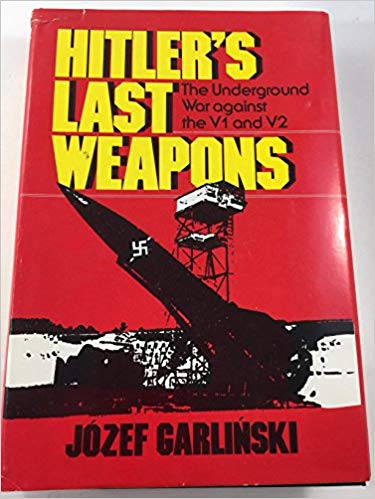Nazi Concentration Camps Low Survivorship Garlinski

Hitler’s Last Weapons, by Jozef Garlinski. 1978
Espionage Thriller: Poles Steal Fallen German V2 Rocket. Nazi Concentration Camps and Death Camps: Comparable Mortality. Yalta Inexcusable
This book provides a detailed history of the German Nazi development of the V1 and V2 weapons, and the role of the Allies (notably the Polish Underground) in uncovering the secrets of their design.
WARNING: This book contains details of Gestapo tortures. They may be upsetting to sensitive readers.
NO VALID DUALISM BETWEEN NAZI GERMAN CONCENTRATION CAMPS AND NAZI GERMAN DEATH CAMPS
Nowadays, as a result of Holocaust supremacism, we commonly see an Orwellian dichotomy between so-called extermination camps (where–incorrectly said–only Jews died) and “ordinary” concentration camps (where mostly non-Jews died), further dramatized by the claim that admission to a so-called extermination camp was special insofar as it was a 100% guarantee of death. [Actually, not even that was true. In most if not all death camps, some Jewish arrivals were diverted to forced labor, and some of these ended up surviving the German-made Holocaust. In addition, quite a few Jews were diverted to forced labor and not sent to the so-called extermination camps in the first place.]
Author Jozef Garlinski, an Auschwitz inmate himself, estimates the mortality at 15% at Dora in contrast to 84% at Auschwitz. So, while 84% is not technically the (incorrectly-claimed) 100%, it is mighty close. And who was better off, the Jew who got to die quickly from the Zyklon gas, or the Pole who died slowly from starvation and overwork?
NO VALID EXCULPATION FOR THE SELLOUT OF POLAND AT TEHERAN (1943) AND YALTA (1945)
Nowadays, we commonly hear excuses for the betrayal of Poland, such as the “nothing could be done because the Red Army was in Poland.” In actuality, the unilateral appeasement of the Soviet Union, by the British, began soon after the Nazi German attack on its erstwhile Soviet ally, moreover at a time when the Soviet Union was at its weakest position–in fact, on the ropes.
Thus, Garlinski points out that, within 24 hours of the German attack on the Soviet Union, Winston Churchill promised “every assistance with no political conditions.” (p. 50). This statement must have emboldened Stalin. It sent a clear message that the British, from the very beginning, had no interest in justice for Poland. The British had already taken the first step in the betrayal of Poland to the Soviet Union, culminating years later at Teheran and Yalta.
THE EXISTENCE OF GERMAN ROCKET WEAPONRY IS UNMASKED BY THE POLES
The Germans made the mistake of using foreign forced labor at their top-secret testing site at Peenemunde. This made it possible for agents to pass the location and significance of this site on to the British. Surreptitious aerial reconnaissance confirmed the rocket-testing nature of this site, and a British air-raid destroyed a large fraction of this facility. The Germans were completely fooled into thinking that the intended target had been Berlin.
The Germans made the second mistake of moving the testing site to Blizna, a location in German-occupied Poland. Was it safe from prying eyes? Hardly! The Polish Underground had no problem monitoring the rocket tests and reporting on them. A nearly-intact V2 rocket fell nearby, and was concealed, taken apart, and photographed by the Polish Underground. The Underground actually smuggled some V2 parts into England. This was part of Operation Wildhorn.
EARLY MILITARY SIGNIFICANCE OF THE V2-THEFT POLISH INTELLIGENCE COUP
Although there was no direct defense against this new German weapon, the British were relieved to learn that the V2 had “only” a one-ton warhead, not a five or ten-ton warhead as originally feared.
Garlinski provides a table of V1 and V2 attacks, giving the cities which were hit and the approximate numbers of dead and wounded.
THE GERMANS GO UNDERGROUND–LITERALLY
The Germans built an underground factory (Mittelbau Dora) in the Harz Mountains, near Nordhausen. It was inside the Kohnstein Mountain, and was bomb-proof. The work conditions for the slave laborers were horrible, but, as noted earlier, not as bad as at Auschwitz.
Thanks to further Polish espionage activities, the Allies learned of the existence and significance of this underground factory. Garlinski (p. 188) touches upon an American plan to attack Kohnstein Mountain with a gasoline-soap mixture (evidently an early form of napalm) in the expectation that the fumes would seep down the ventilation shafts into the underground factory, ignite there, and burn out the interior. It was never attempted.
However, although the factory itself could not be knocked out by conventional bombing, its productivity was reduced by the Allied bombing of the incoming railroad tracks and other supportive above-ground infrastructure. (There is no mention the destruction of Nordhausen itself, which may have been part of this strategy).
To see a series of truncated reviews in a Category click on that Category:
- All reviews
- Anti-Christian Tendencies
- Anti-Polish Trends
- Censorship on Poles and Jews
- Communization of Poland
- Cultural Marxism
- German Guilt Dilution
- Holocaust Industry
- Interwar Polish-Jewish Relations
- Jewish Collaboration
- Jewish Economic Dominance
- Jews Antagonize Poland
- Jews Not Faultless
- Jews' Holocaust Dominates
- Jews' Holocaust Non-Special
- Nazi Crimes and Communist Crimes Were Equal
- Opinion-Forming Anti-Polonism
- Pogrom Mongering
- Poland in World War II
- Polish Jew-Rescue Ingratitude
- Polish Nationalism
- Polish Non-Complicity
- Polish-Ukrainian Relations
- Polokaust
- Premodern Poland
- Recent Polish-Jewish Relations
- The Decadent West
- The Jew as Other
- Understanding Nazi Germany
- Why Jews a "Problem"
- Zydokomuna